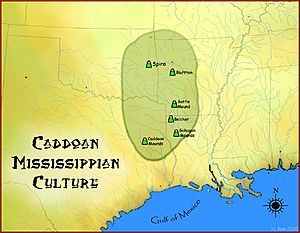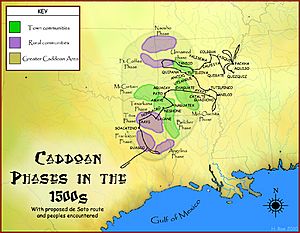Belcher Mound Site facts for kids
| Location | Belcher, Louisiana, Caddo Parish, Louisiana, |
|---|---|
| Region | Caddo Parish, Louisiana |
| Coordinates | 32°45′5.83″N 93°49′27.37″W / 32.7516194°N 93.8242694°W |
| History | |
| Founded | 1400 CE |
| Cultures | Caddoan Mississippian culture |
| Site notes | |
| Excavation dates | 1959 to 1969 |
| Archaeologists | Clarence H. Webb |
| Architecture | |
| Architectural styles | Platform mounds, |
| Responsible body: private | |
The Belcher Mound Site (also known as 16CD13) is an ancient place in Caddo Parish, Louisiana. It's an archaeological site, which means it's where scientists study how people lived long ago. The site is located near the Red River, about 20 miles north of Shreveport.
This important site is named after the nearby town of Belcher, Louisiana. From 1959 to 1969, an archaeologist named Clarence H. Webb led digs here. The Belcher Mound Site gives its name to a specific time period called the Belcher Phase. This phase was part of the Caddoan Mississippian culture and lasted from about 1400 to 1600 CE.
Contents
Exploring the Belcher Mound Site
The Belcher Site was a busy community with a special mound, a cemetery, and a village area. People lived here from around 900 to 1700 CE. The large mound at Belcher was built in many layers over time.
Each layer of the mound had a building on top. After a building was used for a while, it was either burned or left empty. Then, the people would cover it with a new layer of earth and build another structure on top.
Ancient Buildings and Homes
The earliest buildings on the mound were rectangular. Their walls were made of "wattle and daub" (a mix of woven sticks and mud). They had grass thatched gable roofs, which are roofs with two sloping sides.
Later, the people built circular structures on the mound. These had supports inside for the roof and a central hearth or fireplace. They used the same materials for these round homes. These larger buildings on the mounds might have been special places for ceremonies. They could also have been homes for important leaders or chiefs.
Burial Traditions
The people of the Belcher site had a unique way of burying their dead. They would dig pits under the floors of their houses and place their loved ones there. Between 1936 and 1954, Dr. Webb found the remains of 46 people during his excavations.
Along with the remains, he found special items that were buried with them. These included pottery, a ceramic spindle whorl (used for spinning thread), a hair ornament, a stone celt (a type of axe), and shell artifacts. These remains and objects were later returned to the Caddo Nation of Oklahoma, who are the descendants of the people who lived at Belcher.
What They Ate
The people of the Belcher site were skilled farmers. They grew many different plants for food. Their main crops included maize (corn) and beans.
They also gathered wild foods from their surroundings. These included hickory nuts, persimmon seeds, and pecans. From the local rivers and streams, they caught fish like mussels, gar, catfish, buffalo, sheepshead, and bowfin. They also ate turtles. In the nearby forests, they hunted animals like whitetail deer, rabbits, squirrels, foxes, mink, and various birds.
Tools They Used
The Belcher people were very clever at making tools. They used different kinds of rocks to create celts (axes), arrow points, flint scrapers, and tools for engraving. They also made smooth, flat stones called hones for sharpening other tools.
From animal bones, they crafted useful items like awls (for piercing holes), needles, and chisels. For farming, they even made hoes from mussel shells.
The Belcher Phase Culture
Archaeologists have learned that the Belcher Phase began around 1400 CE and lasted until about 1600 CE. At the start of this period, the Belcher culture likely existed alongside another culture called the Bossier culture.
The Belcher people had neighbors too. To the northwest, along the Red River, was the Texarkana Phase. Even further upstream was the McCurtain Phase. Belcher Phase sites have been found from Fulton, Arkansas all the way down to just below Shreveport.
Community Life
The sites from the Texarkana and Belcher Phases varied in size. Some were large, permanent settlements with mounds and cemeteries. Others were smaller, spread-out communities called hamlets or individual farmsteads.
The people in these communities were farmers who grew maize (corn). They had complex societies, meaning they had different groups of people with different roles. Important leaders lived at the mound centers, like the Belcher Mound itself. Other significant mound centers included the Battle Mound, Hatchel-Mitchell Site, and Cabe Mounds. Smaller hamlets and farmsteads, like the Cedar Grove Site and Spirit Lake Site, were also part of the Belcher Phase.
Images for kids








